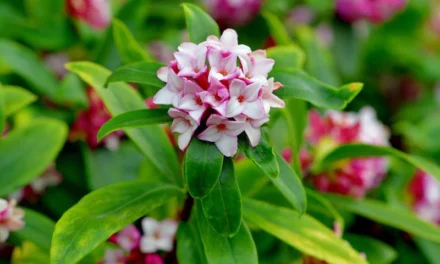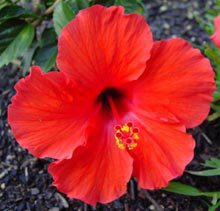 After being out of town for two weeks I was delighted to return and find cooler mornings for the first time in many months. Yes, it is still hot as blazes during the day but the mornings are giving me hope. I am sure this feeling is similar to what those from the far north feel like when the snow begins to melt. It’s a sign, and a good one at that.
After being out of town for two weeks I was delighted to return and find cooler mornings for the first time in many months. Yes, it is still hot as blazes during the day but the mornings are giving me hope. I am sure this feeling is similar to what those from the far north feel like when the snow begins to melt. It’s a sign, and a good one at that.
One of the Crotons on the deck badly needed re-potting so I took advantage of a lovely morning recently to tackle the task. I found a larger container that would complement the many colors of the Croton leaves but it needed some additional drain holes. I don’t understand why manufacturers don’t get it; there are never enough openings for water to drain through. This pot was fiberglass so I used a drill bit called a wood spade or paddle bit. I find this bit works well with its pointy tip to get the hole started then the wider, paddle part enlarges the hole easily. This only took about 3 minutes so while I was drilling, I dug out a tile and glass bit and put drain holes in a ceramic bowl I wanted to use for planting. Tile and glass bits have a stronger material on the tip like tungsten or even diamond dust which grinds through hard materials. I used a ½” size bit and going through heavy ceramic, this was a slower job. Safety goggles are necessary when working with these materials.
The deck on my home is wood; but whatever the material, you never want a container just sitting directly on the deck surface. Moisture would build up under the pot and cause staining and/or damage like rot. I keep all the containers on our deck on some type of riser. In addition to protecting your deck material, this allows air circulation under the pot and usually prevents roots from escaping out the drain holes. My heaviest pots are on rolling plant dollies, this keeps them off the wood and makes it easier to turn or move the pots as necessary. Other pots are on trivet like stands and still others are on what are called “pot feet.” These little gadgets, usually made of clay, like flower pots, are used to raise your container off the deck. They come in all sizes and shapes.
One thing you never want to do is to use a saucer under your outdoor containers. It is not good for the plants to have their roots sitting in water and even a little bit of dampness is all it takes to provide the perfect environment for mosquitoes to breed. We have all read a lot about eliminating mosquitoes recently and I believe preventing any disease that has such devastating effects should be foremost. We all need to take some responsibility and keep our properties free of standing water. In looking around my own back yard I discovered a 5-gallon plastic bucket holding potting soil had a lip on the lid which was holding water. It quickly got taken into the garage. A small thing for sure but every little bit helps.
I hope you were fortunate enough to hear Amanda McNulty at the Port Royal Farmer’s Market recently. Amanda, host of the award winning “Making it Grow” on SC ETV, led a panel and answered audience questions. Of interest was “those little brown spheres” on camellias and sasanquas right now. These are seed pods and they generally hold 2 or 3 shiny brown seeds. The seeds perform best when planted promptly while they are fresh. You might want to scarify (sand or cut the hard outer seed coating) to allow water to penetrate the seed more easily. If you have a good layer of mulch around your plants you may already have a few volunteers growing under there. These babies are likely hybrids and will generally not resemble the parent plants but you never know, you may have a winner. It takes at least 3 or more years to get them to a blooming size.
As you are often told, Fall is the ideal time to plant in our climate. If you need some fresh ideas, and can’t we all use some, do consider visiting public gardens like the Coastal Discovery Museum on Hilton Head Island, where you will find an outstanding Butterfly habitat garden along with a bog garden and the Heritage garden with plants that have existed in the sea island gardens for generations. Another nearby gem is the Coastal Georgia Botanical Gardens at 2 Canebrake Road in Savannah. If you haven’t been there in a while, this property, formerly known as the Bamboo Farm, has been completely revamped. I counted 17 different types of gardens, including a 55,000 gallon water garden with a 9′ waterfall. Do go and see for yourself. You will come away amazed at what can be successfully grown in this area and learn how to incorporate new plant material into your own garden.
Although I already see them in garden centers, it is a little early for mums in the Lowcountry; they will never last long while it is still so warm. But, just to get you fantasizing about fall gardens, I thought I would share this picture I took at a nursery in New Jersey during my recent vacation. The seasonal display caught my eye.







